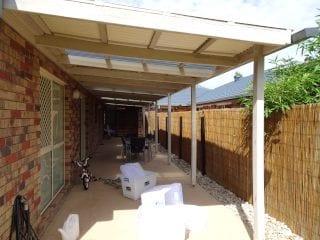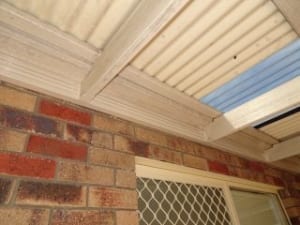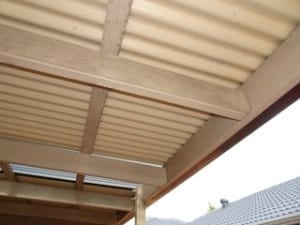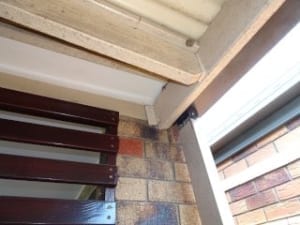Dangers and importance of roof structure securing.
Learn how inadequate securing of a roof structure can be potentially dangerous and how to overcome this fault. QBIS.
Risky & potentially dangerous securing:
Rafters of this patio roof were secured to the metal fascia with pop rivets, this is a potentially dangerous situation, if it collapses. This method of securing is often used by unqualified or inexperienced tradespeople that can be easily avoided with a little more work to make it compliant.
Rafters with insufficient securings to supporting beam.
The opposite ends of the rafters are also inadequately secured with nails only. Secured brackets to junctions of the rafters and supporting beam are required. Alternatively: coachbolts or large batten screws secured through front of the beam and into ends of the rafters.
Insufficient securing of supporting beam attached to house external brick wall.
End of the beam requires brackets that are properly secured to the external brick wall to avoid potential for collapse. The beam takes a considerable amount of the structures weight at this point and must be correctly supported.
Worth knowing:
My client was informed by the local Council that this was common practice and that it would be OK. NOT LIKELY, this practice has never been acceptable.
This structure in not likely to have been built by a qualified builder nor approved by a competent private Certifier.
Try explaining this to your insurer if a non-compliant structure collapses!
What you need to know about securing to metal fascia’s:
- Metal fascia’s are supported by brackets attached to ends of roof trusses. They are not designed to support any structures.
- Structures must be secured to roof structure of the house through the metal fascia by means of brackets. They must not be reliant upon the fascias for support.
What you need to know about illegal/non-compliant structures and insurance companies:
- Illegal/non-compliant structures may not be covered by your insurer for damage they may cause in the event of a storm.
- Disclose any information you have obtained through Council searches and check with your insurer for cover.
Also check with your legal representative, if necessary for professional advice.
Further information that may be of use:
Roof collapse danger
Qld Government worksafe injury prevention, safety and roof collapse
Roof technical notes
Qld Government Technical notes on roofing
QBCC




